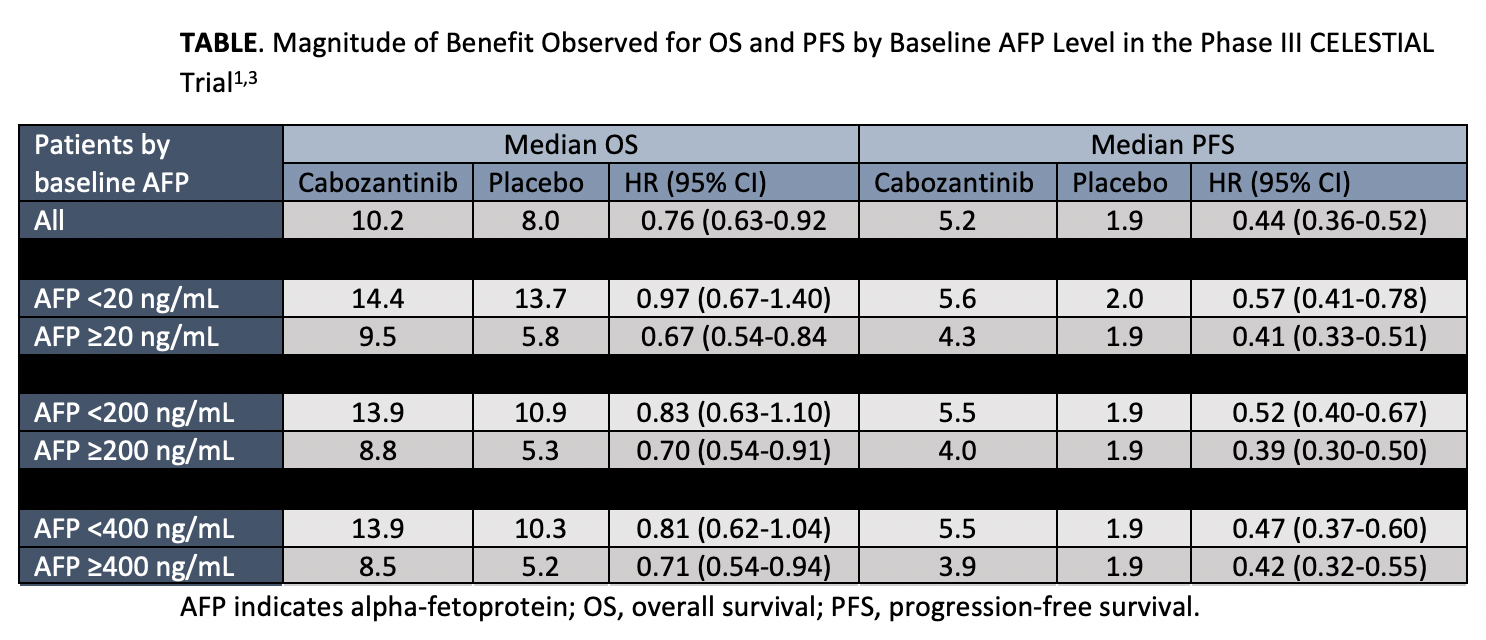AFP Response Could Assist in Cabozantinib Therapy Selection in HCC
Patients with advanced hepatocellular carcinoma treated with cabozantinib had higher alpha-fetoprotein response rates versus those treated with placebo, according to findings of a subanalysis of the phase III CELESTIAL trial.
Robin Katie Kelley, MD

Robin Katie Kelley, MD
Patients with advanced hepatocellular carcinoma (HCC) treated with cabozantinib (Cabometyx) had higher alpha-fetoprotein (AFP) response rates versus those treated with placebo, according to findings of a subanalysis of the phase III CELESTIAL trial. In presenting these findings at the 13th Annual Conference of the International Liver Cancer Association in Chicago, Robin Katie Kelley, MD, argued that the positive outcomes are worth noting and warrant future research into AFP response and at least one area for immediate applicability.
“AFP response, defined as a decrease in AFP levels on or after therapy, has been associated with improved survival in patients with HCC treated with local-regional therapies such as chemotherapy, ablation, or surgery,” said Kelley, associate professor of clinical medicine in the Department of Medicine (Hematology/Oncology) at University of California San Francisco Helen Diller Family Comprehensive Cancer Center. She added that limited data sets from patients treated with systemic therapies, including retrospective cohorts of patients on either first-line sorafenib (Nexavar) or second-line regorafenib (Stivarga) for advanced HCC, also showed similar findings.
Across disease stages for HCC, elevated levels of serum AFP have indicated poor prognosis. Investigators are hopeful AFP response can eventually serve as a biomarker for treatment efficacy.
Results of the CELESTIAL trial previously showed that cabozantinib significantly improved overall survival (OS) and progression-free survival (PFS) over placebo in patients with previously treated advanced HCC, independent of baseline AFP. Patients were eligible if they had progressed following at least 1 and up to 2 prior systemic therapies. They were then randomized 2:1 to cabozantinib 60 mg a day versus matched placebo. Tumors were assessed radiographically using RECIST v1.1 every 8 weeks with a primary endpoint of OS and secondary endpoint of PFS.2
In the overall study population, patients treated with cabozantinib had a median OS of 10.2 months versus 8.0 months with placebo (HR, 0.76; 95% CI, 0.63-0.92;P= 0.005). Likewise, the median PFS also improved with cabozantinib (5.2 vs 1.9 months; HR, 0.44; 95% CI, 0.36-0.52;P< .001).2
Survival Differences Across AFP Levels
Assessing efficacy by baseline AFP levels, cabozantinib improved OS and PFS compared with placebo across a range of baseline AFP levels. Higher AFP levels were consistently associated with a greater magnitude of benefit with cabozantinib versus placebo.3
Another consistent finding was that patients with higher AFP levels treated with cabozantinib had shorter OS and PFS than patients in the low-AFP group (TABLE).
“What these data tell us is that baseline AFP level does not predict for any different response on cabozantinib. Rather, that cabozantinib improves PFS and OS independent of the AFP. Stated another way, this suggests that baseline AFP is not a predictive marker for cabozantinib response,” said Kelley.
In the subanalysis, serum AFP level was assessed at baseline and every 8 weeks during treatment. It’s important to note that both patients and providers were blinded to central AFP results, said Kelley.1
Changes in AFP levels were assessed in patients with evaluable baseline AFP ≥20 ng/mL, with potential for low-level fluctuations for patients with chronic liver disease or viral hepatitis. This cutpoint was arbitrary, said Kelley, and based solely on previously used cutpoints in the literature. One aim of future studies, she said, should be to focus on defining and validating cutpoints for AFP response.

OS and PFS were then analyzed versus AFP response and progression using 2 different cut offs. AFP response was defined as a ≥20% or ≥50% decrease from baseline while AFP progression was defined as a ≥20% or ≥ 50% increase from baseline.
In the overall population, approximately 70% of patients had elevated baseline AFP or evaluable baseline AFP ≥20 ng/mL. This is consistent with the known distribution of AFP in the advanced HCC population, said Kelley.
About 50% were evaluable for AFP response at week 8. The remaining 50 percent were not evaluable, with 30% excluded because they had AFP levels <20 ng/mL at baseline, and an additional 20% excluded due to baseline AFP above the upper limit of quantification (300,000 for this assay), death, or dropout prior to or missed blood sample at week 8. This may have contributed to study limitations, said Kelley.
A greater proportion of patients had AFP decreases in the cabozantinib arm (n = 236). Patients on the placebo arm (n = 111) had a greater proportion of AFP increases. Fifty percent of patients on cabozantinib had a ≥20% decrease in AFP, with 28% having a ≥50% decrease.
A substantially smaller percentage of patients on placebo (13%) had an AFP response ≥20% decrease, with a 5% subset having a ≥ 50% decrease. Over twice as many patients on placebo had AFP progression compared with cabozantinib (68% vs 31%, respectively). Using the ≥50% cut point, corresponding rates of AFP progressions were 51% and 20%. The small response on placebo caused the investigators to focus exclusively on the cabozantinib group for further analysis.
The baseline characteristics of the cabozantinib-treated patients were similar for both the AFP-response and nonresponse groups, with males accounting for 79% in both groups and median ages of 62 and 63 years, respectively. Approximately 83% had extrahepatic spread and/or macrovascular invasion, noted Kelley.
The median OS was substantially longer in the AFP-response group at 16.1 months compared with 9.1 months in those without an AFP response (HR, 0.61; 95% CI, 0.45-0.84). Median PFS was also longer for patients with AFP response compared with those without response (7.3 vs 4 months; HR, 0.55; 95% CI, 0.41-0.74).
On a multivariable analysis including other established prognostic factorssuch as ECOG performance status, baseline AFP, macrovascular invasion, extrahepatic spread, among others—AFP response was independently and significantly associated with improvement in OS (HR, 0.60;P= .0002) and PFS (HR, 0.56;P= .0002).
Patients with AFP response had longer treatment duration at 5.7 months versus 3.7 months for those without response. The discontinuation rate was 13 percent in both arms which was lower than the overall study population, noted Kelley. AFP response status also contributed to all cause adverse events similar to the overall study population. One notable exception was the rate of diarrhea, which was slightly higher at 17% in the AFP-response group compared with 10% in the all patients. “This suggests a longer time on treatment, but the numbers were too small to discern significance,” says Kelley.
“Further optimal thresholds for AFP evaluability, the optimal cut point and definitions for response and progression, and the optimal time points for measuring response remain to be validated,” said Kelley. She concluded that AFP response “warrants further evaluation as an early surrogate for response or progression to complement existing radiographic tools while on cabozantinib as well as other systemic therapies for advanced HCC now that there are multiple treatment options available for progression for this population.”
References
- Kelley RK, Bocobo AG, Goyal L, et al. Alpha-fetoprotein (AFP) response and efficacy outcomes in the phase 3 CELESTRIAL trial of cabozantinib versus placebo in advanced hepatocellular carcinoma (HCC). Presented at: 13th Annual Conferences of the International Liver Cancer Association; September 20-22, 2019; Chicago, IL. bit.ly/2m1pOR2.
- Abou-Alfa GK, Meyer T, Cheng A-L. et al. Cabozantinib in patients with advanced and progressing hepatocellular carcinoma.N Engl J Med. Cabozantinib in patients with advanced and progressing hepatocellular carcinoma. 2018;379(1):54-63. doi: 10.1056/NEJMoa1717002.
- Kelley RK, Al-Khoueiry AB, Meyer T, et al. Outcomes by baseline alpha-fetoprotein (AFP) levels in the phase III CELESTIAL trial of cabozantinib (C) versus placebo (P) in previously treated advanced hepatocellular carcinoma (HCC).Ann Oncol. 2018;29(suppl 8;abstr 702P). doi: 10.1093/anon/mdy282.085.